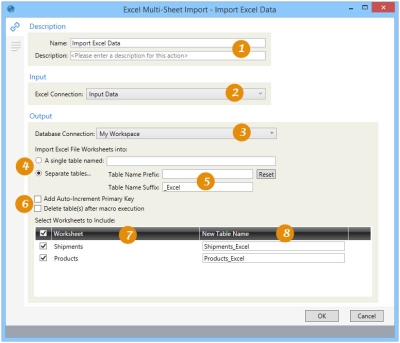Importing multiple Excel worksheets or named ranges
The Excel Multi-Sheet Import ![]() action allows you to import data from multiple worksheets and/or named ranges in an Excel file using just one instance of the action. A new table is created for each worksheet and/or named range. You can:
action allows you to import data from multiple worksheets and/or named ranges in an Excel file using just one instance of the action. A new table is created for each worksheet and/or named range. You can:
- Choose which worksheets to import
- Import worksheets into separate tables or a common table -
- Import worksheets with different formats into separate tables
- Import worksheets with same format into the same table or separate tables
- Assign a common prefix and/or extension to all tables created
On the Connections tab:
-
Enter a name and a description.
-
Select the input connection.
-
Select the output connection.
-
Indicate the import option: either single table or separate tables.
-
Specify an optional prefix and optional suffix for the new table names.
-
Optionally, add an auto-increment key to output tables and/or delete tables after execution.
-
Choose the worksheets to be imported.
-
Enter the new table names.
The most common application is to import data stored in Excel spreadsheets and named ranges.
Import multiple Excel worksheets or named ranges
- Drag the Excel Multi-Sheet Import icon onto the design surface.
- On the Connections tab
 , enter a Name and a Description to identify the action, then specify the input Excel worksheet and output database table options:
, enter a Name and a Description to identify the action, then specify the input Excel worksheet and output database table options:Input -
- For Excel Connection, specify the Excel file from which the worksheets are being imported, or choose New Excel Connection to establish a new connection.
Output -
- For Database Connection, specify the database to which the data is being imported.
- Indicate whether to import the worksheets into a single table or separate tables for each worksheet -
- If the worksheets you are importing have matching data schemas, and you want to import them into a single table, select A Single Table named and then specify the name of the table.
- To import each worksheet into a separate table, select Separate Tables.
- Specify a Table Name Prefix and Table Name Suffix for the new tables.
- Use Reset to return any manually-modified New Table name back to its default value of Table Name Prefix + Worksheet + Table Name Suffix.
- If the worksheets you are importing have matching data schemas, and you want to import them into a single table, select A Single Table named and then specify the name of the table.
- Indicate whether to include an auto-increment primary key in each output table.
- Indicate whether the output tables should be deleted following successful execution of the macro containing the import action.
- Select the worksheets to be imported. You can select the checkbox above the list of available worksheets to select the entire list, or you can select them individually.
- If you are importing into a single table, the New Table fields are filled in automatically and cannot be changed individually.
- If you are importing into separate tables, the New Table fields are filled in with the original worksheet name plus the prefix and suffix you specify.
- If enabled in User Preferences, use the Performance tab
 to change certain execution settings specific to this action. Refer to Change general preferences for additional information.
to change certain execution settings specific to this action. Refer to Change general preferences for additional information.
Last modified: Thursday December 19, 2024

